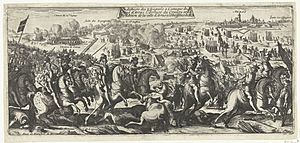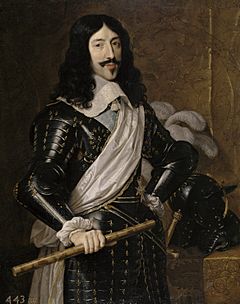Siege of Arras (1640) facts for kids
Quick facts for kids Siege of Arras |
|||||||
|---|---|---|---|---|---|---|---|
 Siege of Arras; the French defeat a Spanish sortie, 8 August |
|||||||
|
|||||||
| Belligerents | |||||||
| Commanders and leaders | |||||||
| Strength | |||||||
| 32,000 | 2,000 | ||||||
| Casualties and losses | |||||||
| unknown | minimal | ||||||
The Siege of Arras was an important battle that happened from June 22 to August 9, 1640. It was part of the Franco-Spanish War, which was connected to the bigger Thirty Years' War happening in Europe.
During the siege, a French army surrounded the town of Arras. At that time, Arras was controlled by Spain and was the capital of a region called Artois. It was part of the Spanish Netherlands. The town held out for 48 days before finally surrendering to the French.
Arras was defended by about 2,000 soldiers, led by Owen Roe O'Neill. He was an Irish soldier serving Spain. Even though a Spanish army tried to stop the French from getting supplies, the French eventually got more food. This made the Spanish defenders give up on August 9.
Arras became part of France after the Treaty of the Pyrenees in 1659 and has been French ever since. A famous French writer, Cyrano de Bergerac, was also part of this siege. He was hurt during a Spanish attack on August 8.
Why the Siege Happened

In the 1600s, two powerful families, the Bourbons of France and the Habsburgs of Spain and the Holy Roman Empire, were often fighting. Many historians believe that the Thirty Years War (1618-1648) and the Dutch Revolt (1568-1648) were all part of this bigger struggle between these two families. Understanding this helps explain why the Franco-Spanish War started.
The Habsburgs controlled lands like the Spanish Netherlands (which is now Belgium and parts of the Netherlands), Franche-Comté, and areas near the Pyrenees mountains. These lands surrounded France and made it hard for France to expand. They also made France feel like it could be attacked easily.
France had its own problems, like the Huguenot rebellions (religious conflicts) from 1621 to 1629. So, France tried to weaken the Habsburgs without fighting them directly. For example, France supported the Dutch in their fight against Spain. France also paid Sweden to fight in the Holy Roman Empire starting in 1630.
In 1621, Spain restarted its war against the Dutch. Spain won some battles at first, but by 1633, they were losing again. Some people in the Netherlands wanted to make peace. At the same time, Sweden and its German allies were defeated in 1634. Many of their allies then left the war after the 1635 Treaty of Prague.
King Louis XIII of France and his main advisor, Cardinal Richelieu, worried that the Habsburgs might make peace and become even stronger. So, they decided France should join the war directly. In February 1635, France made an alliance with the Dutch. They agreed to divide the Spanish Netherlands between them. In April, France also signed a treaty with Sweden.
In the first three years of the war, the experienced Spanish army won many battles against the French. However, in 1638, France and the Dutch attacked the Spanish Netherlands together. Even though this attack didn't fully succeed, it forced Spain to defend itself more. After capturing the town of Hesdin in 1639, France decided that its next goal for 1640 would be Arras, the capital of Artois.
The Siege of Arras
Arras was a very strong town with new defenses. It also had four waterways around it. These waterways made it hard for an army to surround the town completely. They also made it difficult for the attacking army to move supplies and communicate.
To weaken the defenders in Arras, a French force led by de Châtillon first attacked smaller towns like Aire-sur-la-Lys and Béthune. This made Spain send some soldiers from Arras to help defend those towns.
After this, de Châtillon joined forces with de Chaulnes and de la Meilleraye. Their combined army of 32,000 men then marched towards Arras. The town's defense was now down to about 2,000 men. They were commanded by Owen Roe O'Neill, an Irish soldier who had served in the Spanish army for many years.
The biggest challenge for the French was feeding such a large army. Instead of attacking the French directly, the Spanish army, led by Charles of Lorraine, focused on stopping supplies from reaching them. By July, the French army had less food than the soldiers inside Arras. The French commanders faced a tough choice: either retreat or attack Charles of Lorraine on his chosen battlefield.
Cardinal Richelieu, who was nearby in Doullens, was very strict. He told his commanders they would "pay with their heads" if Arras was not captured. But he also sent a large convoy of supplies. This convoy, led by François de L'Hospital, reached the French camp on August 2.
Inside Arras, the defenders were running out of food and were even eating rats. It was clear they could not hold out much longer. Charles of Lorraine was told not to risk his army in a big battle.
On August 8, the French were close to breaking through the eastern wall of Arras. Owen Roe O'Neill launched a sortie (a sudden attack from a besieged place) to try and break the French lines. This attack failed. During this fight, Cyrano de Bergerac, the famous French writer, was wounded. The very next day, O'Neill surrendered. His soldiers and thousands of civilians were allowed to leave safely for Lille.
What Happened Next
After taking Arras, the French quickly took control of the rest of Artois. More importantly, Spain was finding it harder and harder to fight wars on so many different fronts. Throughout the 1630s, people in Spain protested against attempts to raise taxes. In 1640, this led to big revolts in Portugal and Catalonia.
Many Spanish officials also felt it was time to accept that the Dutch were independent. Despite these challenges, Spain, with help from the Austrian Habsburgs, remained a powerful country.
Spain officially recognized the independence of the Dutch Republic with the Peace of Münster, which was signed on January 30, 1648.
Sources
See also
 In Spanish: Sitio de Arras para niños
In Spanish: Sitio de Arras para niños

